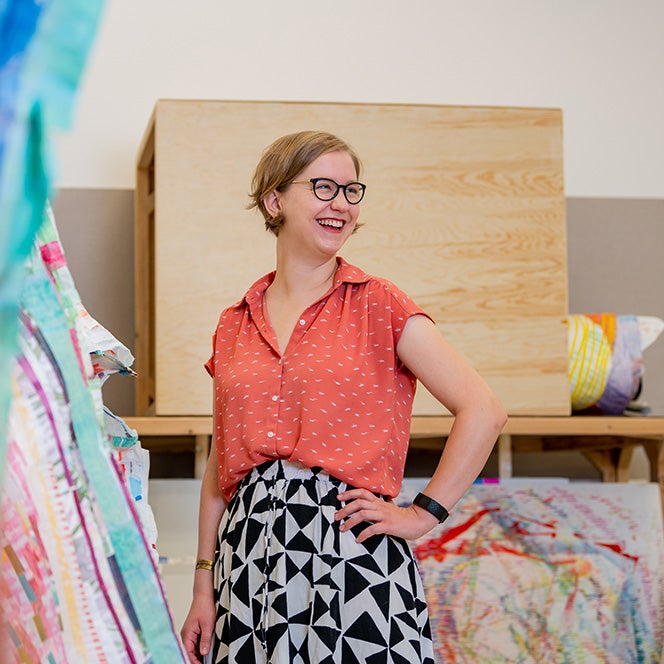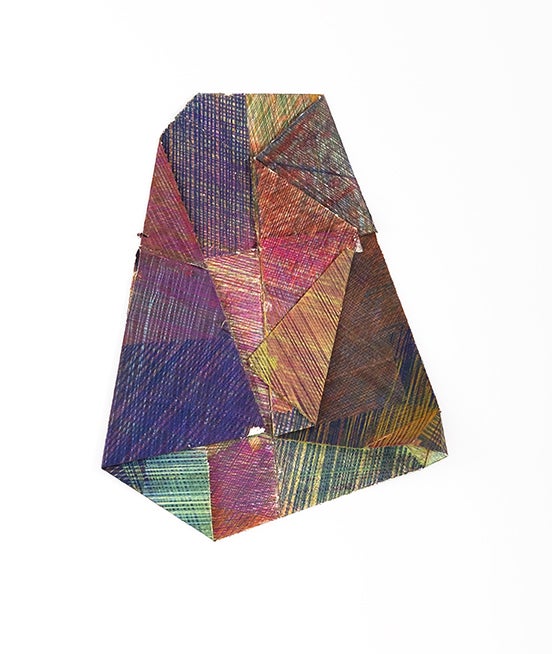Astri Snodgrass, an assistant professor of drawing and painting at Boise State, shares her thoughts about art, the creative process, family and her Norwegian heritage.
Can you tell us about your current artworks?
I’ve been working on some pieces that are essentially paper quilts. I’ve been interested in textiles and fibers and how that relates to both my family history and art history. I am interested in quilts in particular because of the nature of pulling from so many different sources. A lot of my work is, in essence, collage-based, and one of the main challenges with collage is making these disparate parts feel as if they belong together. This is interesting on a technical level, but also on a conceptual level: what it means to bring things together that didn’t necessarily start together.
How do you create these pieces?
I machine sew a very fine but strong paper called kozo paper made from the mulberry plant that takes water media well. It’s a very beautiful material to work with for staining using acrylic paints and inks. For the past seven or eight years, my work has been a lot of cannibalizing previous work, and then adding new materials. I’m interested in thinking about my practice like a garden, or like a sourdough starter that you have to actively cultivate, where it kind of breaks down and becomes something rich and new, almost like compost.

What you are discovering in the process of creating?
I like to think about my art as families of work instead of bodies of work because they are all interconnected over a period of time. There will be components across multiple pieces that visually connect them but also connect them in terms of a single source. So I’m thinking about that relating to origins and genetics and family, kind of as blood lines that connect people.
How does the idea of ‘family’ impact the way you create art?
I’ve always been interested in the handmade and the connection to the domestic with more fiber-based work. My grandparents immigrated to the U.S. from Norway, so there’s this strong connection to fiber work on that side of my family where that was sometimes my sole connection with relatives abroad: receiving a hand knit sweater for Christmas. So this connection between fibers and family just runs deep in my life.

Ink, gouache, colored pencil, wax pastels and cold wax medium on Rives BFK paper
What is something unique about Norwegian culture?
Have you heard of hygge? We have a very similar concept in Norwegian, called kos (pronounced ‘koos’). I think a few years ago, I read that Norway spent more money per capita on interior design than any other country, which has to do with how much of the year they spend inside. It’s really, really dark and really cold. That focus on the domestic and on personal space and home and how textiles, particularly handmade textiles, can contribute to that sense of kos: that’s what I grew up with in a Norwegian American home. Often kos is talked about as bringing a little bit of summer inside in the winter.
What is your piece of advice for people who think they don’t ‘understand’ art?
There’s so much art that I don’t understand. And I think that focusing solely on that aspect of ‘understanding’ or ‘getting it’ is reductive to what the work can do and how one could engage with it. In general, our culture needs to be better at cultivating curiosity, rather than an immediate appraisal of artworks’ value. If you can sit with the creative piece a little bit longer than your initial judgment, you are able to get so much more out of that. The fact that I don’t understand so much about art is kind of what fuels me as an artist, that it is this intensely enigmatic field, that it’s inexhaustible in terms of how one could understand it or engage with it.
-Article by Brianne Phillips, video by Matt Crook, studio photography by Priscilla Grover, art exhibit photos by Carrie Quinney
